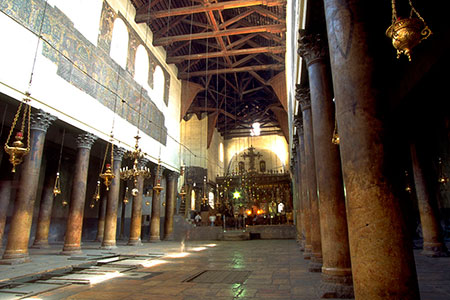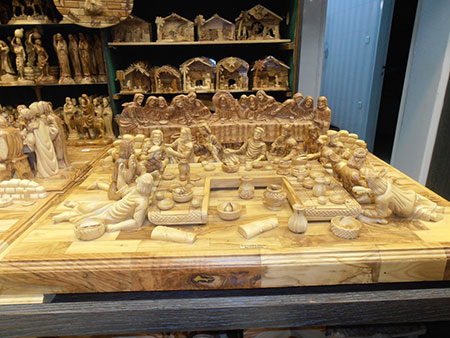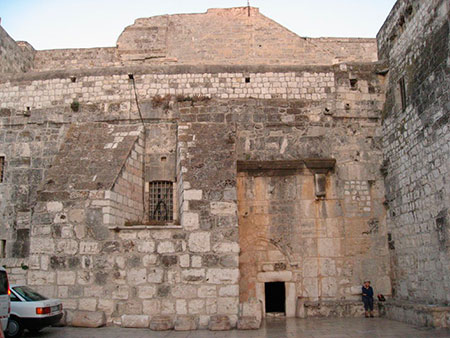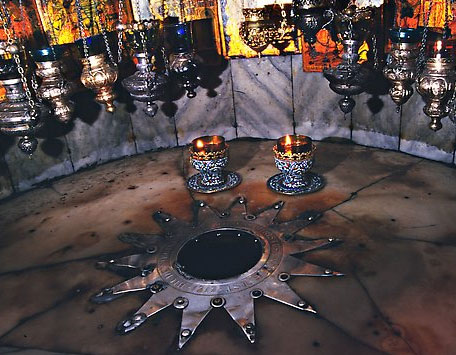Off Limits
13 March 1990

As I walk down the road
I sit up some
The lambs were coming homeward one by one
I heard a sheep bell softly calling them
Along the little road to Bethlehem
– Lyrics by Michael Head and Margaret Rose
So, off we went to Palestine, late in the afternoon. There had been sunshine at the Basilica of the Agony, but clouds were coming in. There was little traffic, since this was more than two months after the crush of Christmas, well ahead of the Spring Break and summer touring, and we were three years into the Intifada, the mass boycott of all things Israeli. We were forced to come down from our scrape with religious rapture, as we passed out of the Old City on The Route of the Patriarchs (Rt. 60) to the south toward Bethlehem.
The revolt had started three years before, in December of 1987. It was sparked by a traffic accident in which an Israeli army tank transporter at the Erez checkpoint crashed into a row of cars containing Palestinians returning to Gaza from working in Israel. Four of them died and seven more were injured. Since the accident occurred at rush hour, there was a crowd of hundreds to witness the event.
At the funerals, ten thousand turned out, many from the Jabalya refugee camp, the biggest in Gaza. Inflamed by accounts that the crash had been a deliberate response to the stabbing of an Israeli businessman in Gaza a few days before, large-scale demonstrations were scheduled and they turned violent when a Molotov cocktail was thrown at a passing police cruiser. The IDF responded with rifle fire that left a young Palestinian dead and more than a dozen wounded.
Protests rapidly spread into the West Bank and East Jerusalem. Palestinian shopkeepers closed their businesses, and workers failed to report to their jobs in Israel. Soon there were road-blocking and stone-throwing incidents throughout Gaza and the West Bank. By the time we got there, an uneasy peace was in place, but widespread civil disobedience was common and the economic boycott went on, though it was clear that many of the local merchants really wanted to do business with us.
The Navy was taking no chances and places all the occupied territories off limits to the crew of the FID and our escorts. So naturally we had no alternative to violating the rules in our quest.
Our driver Svi assured us it would be with minimal risk. We wanted to go, and we went, Navy and intifada be damned. We drove past mounds of stones by the road. “The old check-point from before 1967,” Svi said, waving a hand at them.
Lutt-man and the Doc were quiet and a little concerned that we might run into something that would get us in trouble back on the ship. I felt exhaustion coming on. We had been power-touring all day and drinking exuberantly since we got off the ship in Haifa. But we couldn’t miss the Grotto, and as it turned out, I was very glad that we did when we had the chance.
Really, you could have walked to Bethlehem if you wanted, and didn’t run into an IDF patrol or a band of Palestinian demonstrators. It is only about six clicks down Rt. 60, and we were at the outskirts of the town in a flash. Svi pulled the Mercedes into the parking lot of a quiet looking shop to enable us to shop for some souvenirs from the Christian owners of the shop, members of one of the largest settlements of that faith remaining in the Middle East. I assume that Svi had an agreement to steer his tourists to the place, where two brothers with alert dark eyes hovered around us, clearly hoping we were big spenders.

“The intifada is killing our business,” said one in softly rounded English. “Bethlehem has been sealed off by the army, virtually destroying our tourism, and keeping workers from going to their jobs in Jerusalem. I don’t know how long we can hang on here.”
I felt bad for them and bought a model crèche crafted of olive wood, some red clay oil lamps of antique design, postcards of he Grotto and a couple pottery candlesticks with thumbholes. I was not exactly going to keep them in business, but Doc and Lutt-man did their bit as well and we walked out of the shop and back to the car with bags of things to give away back home. From the shop to Manger Square was a matter of a couple minutes.

There were only a few tourists on the square and the place looked a little forlorn.
I was chilled from riding shotgun next to the open window with the late afternoon breeze. It hadn’t been so bad when the sun was out, it was now gray. Gray stones, gray sky. Svi rolled down Manger Street to the Square and parked the car in the plaza in front of the Church of the Nativity. Doc had a guidebook, and he briefed us as we walked toward the odd-looking entrance to the Church.
“This is one of the oldest Christian Churches on earth,” he said, slipping the book into his jacket pocket. The first version was commissioned by the Emperor Constantine the Great in 330 AD.”
“That shows you something about the scale of that empire,” I said. “They have peep-hole cut in the floor of the Cathedral at York in East Anglia to show the foundation of the Roman Governor’s house where Constantine’s old man died and he became Caesar. And he later built this place all the way across Europe.”
Lutt-man looked at the entrance, which had once been a graceful arch, blocked up with cruder cut stones. “What is up with that? Why would they block it all up like that?”
Doc looked puzzled and consulted his guidebook then said: “The Crusaders fortified the structure, and they probably did want they probably didn’t the Mamluks riding their horses in to defile the Shrine. The call it the Door of Humility now, since you have to stoop to get in.”
And stoop we did, as we entered the Church through the small door. We discovered it was fairly austere on inside, in keeping with the exterior. I was getting a little numb to the decorations of holy places by this point in the day, and we trooped through the nave to get to the narrow staircase at the front of the Church that is used to access the Grotto. Christ was not born in a stable, after all, and the crèche I had purchased only perpetuated the myth.

Three fiercely-bearded priests in dark cassocks- I assumed they were Greek Orthodox, though the duties are shared with the Armenians and the Romans- waved censers suspended on three brass chains while chanting in low voices. The smell of the incense was almost overwhelming in the dimness, but it was clear enough to see the silver star on the floor that marks the exact spot the Emperor’s people decided that Christ had been born.
Doc leaned over to whisper in my ear: “The censer symbolizes the Lady, the Theotokos. The charcoal is inside the censer and does not burn, so the Lady Theotokos received Christ and did not get burnt, but instead was exalted and enlightened.”
“Right,” I whispered back.
The Grotto was very strange, as strange in its way as the Sepulcher had been in Jerusalem, though I did not feel the same incredible sense of lightness that we experienced at the Garden Tomb or in the garden at Gethsemane. Maybe we were getting tired. We took a moment to let the moment sink in, and then turned to retrace our steps to the Door of Humility and the Square.
Svi was waiting patiently, though the twilight was coming on strong.
“Would you like to see The Milk Chapel or Shepherd’s Fields? I am afraid you won’t be able to see much in the dark if we go to the ruins of the palace at Herodium,” said Svi.
We looked at one another. “We managed not to get busted for being off limits. So maybe we ought to just get back to Tel Aviv and get a drink or two,” said Lutt-man. “I vote we go back to the Hilton.”
Svi wasn’t the only one who seemed relieved that the end of the journey was in sight and we rolled down Manger Street to get back to Rt. 60 and head north. The wind was downright cool as it blew through the window, broken as part of the Palestinian rebellion. I pulled up the collar of my jacket against the chill, and I slept my way past the old checkpoint and back into Israel and all the way to the hotel.
Copyright 2016 Vic Socotra
www.vicsocotra.com
Twitter: @jayare303
